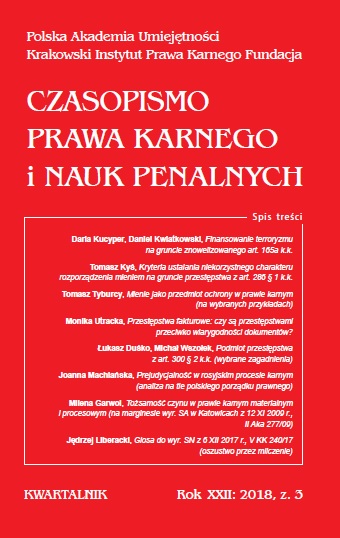Mienie jako przedmiot ochrony w prawie karnym
(na wybranych przykładach)
Property as a subject of protection in criminal law (selected examples)
Author(s): Tomasz TyburcySubject(s): Criminal Law
Published by: Polska Akademia Umiejętności / Krakowski Instytut Prawa Karnego Fundacja
Keywords: property; property rights; item; possession; ownership
Summary/Abstract: Mienie występuje w Kodeksie karnym w trzech znaczeniach. Pierwsze jest tożsame z ujęciem cywilistycznym i odnosi się do rodzajowego przedmiotu ochrony. Ma ono charakter abstrakcyjny i jest rozumiane jako zespół praw majątkowych. Drugi sposób prawnokarnego rozumienia mienia należy przyjmować przy określeniu przedmiotu czynności wykonawczej. W tym znaczeniu mienie ma charakter konkretny i jest bliskoznaczne pojęciu rzeczy. Należy przez nie rozumieć konkretne materialne przedmioty, które są fizycznym odzwierciedleniem praw majątkowych (mienia w rozumieniu cywilistycznym). W doktrynie pojawia się także trzeci sposób rozumienia omawianego terminu, który przyjmuje znaczenie cywilistyczne (prawa majątkowe) w odniesieniu do konkretnej rzeczy lub energii. Wydaje się, że mienie leży jakby na dwóch płaszczyznach: prawa majątkowe (sfera normatywna) do rzeczy (sfera fizyczna). Ten sposób rozumienia pojęcia „mienie” wydaje się optymalny na przykład do określenia indywidualnego przedmiotu ochrony art. 278 § 1 k.k. Sprzyja on koherentności Kodeksu karnego, ponieważ definiuje przedmiot wykonawczy (rzecz) w odniesieniu do indywidualnego przedmiotu ochrony (prawa majątkowe). Mienie jako przedmiot czynności wykonawczej ma, w zależności od typu czynu zabronionego, węższy lub szerszy zakres znaczeniowy. W znaczeniu węższym, które należy przyjmować przy kradzieży, obejmuje ono generalnie rzeczy oraz energie. Natomiast w znaczeniu szerszym mienie oznacza wszelkie prawa majątkowe: rzeczowe i obligacyjne, stanowiące majątek, i tak należy je rozumieć na przykład w przestępstwie oszustwa lub wymuszenia rozbójniczego. The term “property” has three distinct meanings in the Polish Criminal Code. The first meaning is identical with an approach presented in civil law and refers to the generic object of protection. Therefore, “property” is understood in an abstract manner as a set of property rights. The second meaning attributed to the term “property” refers to criminal law and should be taken into account when defining the object upon which the activity of the perpetrator conducting the prohibited act is directed. In this sense “property” has a concrete nature and is synonymous with the notion of “thing”. It should be understood as referring to the specific material objects that are physical reflections of property rights (property in sense used in civil law). In legal doctrine, there is also a third way of understanding this term, which assumes the civil law meaning (property rights) in relation to a particular thing or energy. It seems that property exists on two levels: property rights (normative sphere) to things (physical sphere). This way of understanding the concept of “property” appears optimal, for example, to define the individual object of protection under Article 278 § 1 of the Polish Criminal Code. This meaning favors the coherence of the Polish Criminal Code because it defines the object upon which the activity of perpetrator conducting the prohibited act is directed in relation to the individual object of protection (property rights). Property as an object of perpetrator’s behavior has, depending on the type of a prohibited act, a narrower or wider scope of meaning. In a narrower sense, which should be adopted in the case of larceny, it generally includes things and energy. On the other hand, in a broader sense, property signifies all property rights and obligations and should be understood in this manner, for example, in cases of crimes of fraud or theft by extortion.
Journal: Czasopismo Prawa Karnego i Nauk Penalnych
- Issue Year: 22/2018
- Issue No: 3
- Page Range: 69-94
- Page Count: 26
- Language: Polish

